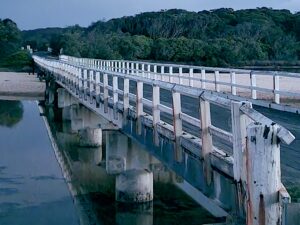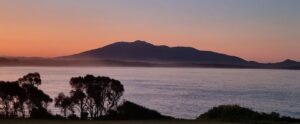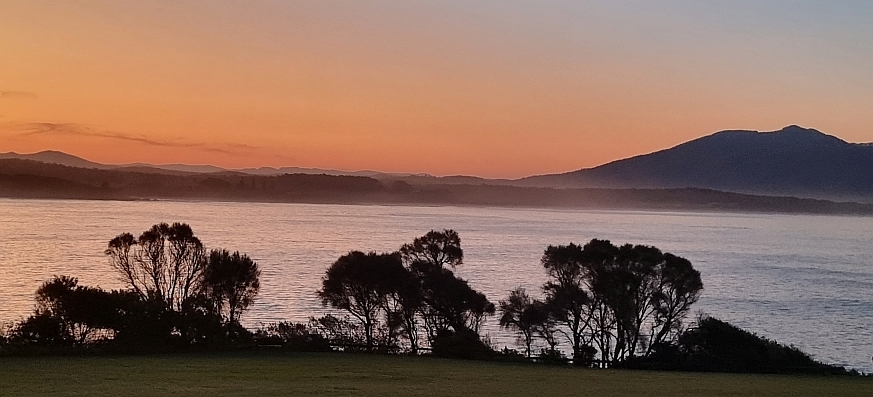Some Voices of Bermagui
John Blay
AN AUSTRALIAN DREAM
Away from it all
A small place
Somewhere by the sea
Or running stream
Like family
To live with the land
By natural values
Where people support
And look after
Each other all for one
And one for all
Everyone knows you
And there´s work
Enough to get by
Every continent has its own great spirit of place. Every people is polarized in some particular locality, which is home, the homeland. Different places on the face of the earth have different vital effluence, different vibration, different chemical exhalation, different polarity with different stars: call it what you like. But the spirit of place is a great reality.
DH Lawrence Studies in Classic American Literature
This is a meditation on a place, or a very personal portrait of an Australian fishing village and its district, told through the voices of its people over time. Or, more you could say it´s a joint quest to find that portrait through the stories of residents. The voices say what the people are thinking about, how they live, what they do, why and how come. Most have been Jacks and Jills-of-all-trades and so many of the tales circle what people have managed to do to survive there. Many went away for a year or two and were almost inevitably drawn back. We find the hopes and prayers and heritage of the district. Common themes form bridges between the many voices over the years and symbolise the changes that link generations and landholdings, and focus our gaze. This work is not so much an oral history of a place, but rather a folk impression of Bermi and its district. More formally known as Bermagui, it is a fishing village on the far south coast of NSW that has always faced an ongoing process of change .
The district for my purposes takes in a clutch of valleys that begin around Mystery Bay in the north, including Tilba, to Moon Bay and Nelson Lake in the south, including Tanja, where the forests come all the way to the ocean. To the west, the forests give way to woodlands and grasslands usually about ten kilometres inland. The basalt soils round Coolagolite and granite soils of the Cobargo valley are fertile and power the introduced kikuyu grass that would in the extreme conditions of the Black Summer fuel terrible firestorms. The district includes Yowrie, at the foot of the wild mountain ranges of Wadbilliga National Park, and takes in Cobargo and Quaama. Its parts are linked together by bridges that entail utility, craftsmanship, aesthetics and heritage. The main three villages of the region, Bermagui, Tilba Tilba and Cobargo, form a rough triangle recognised in the name of their local newspaper, The Triangle.
Essentially, these voices were recorded by me over two periods of a few months in 1975 and 2021, although there are a few extras. During the interviews we expressed our thoughts freely, and it struck me that many residents were wondering whether the district might have qualities special enough to indicate it has a unique personality. Then again, could it be just another typical Australian hometown? The concern of many was whether the changes everyone was noticing might mean the place could lose its spirit. They wanted to keep its distinct character.
Some describe the area as though it’s a bug. Once bitten, you can’t leave. Or, echoing the Kooris, say that once you’ve lived in the shadow of the mountain, you’ll always be drawn back.
The voices of the people in this account seemed to choose themselves at random during the limited time I had to make the recordings. Few had time to consider what they were going to say. I didn´t tell them what I wanted to talk about other than the general subject of the place. The result is no chorus of agreement. They voice their own themes and the issues closest to their own hearts. These interconnect throughout, like bridges. Often contradictory, cantankerous or self-serving, deep down there was a general agreement on a few matters. In 1975 there was little middle ground on whether you were for saving the forests or for the timber industry, but by 2021 opinions were more nuanced. And each branch of the old families had its own version of the history.
My intention has been to plumb not an accurate, detailed history, but the truth in the people’s hearts. Often what they say might be outrageous in modern terms, even unsayable, but this is the way things were spoken then. They told their stories in their own way, usually sitting round in the kitchen or on the verandah. Television only really came to Bermagui in the early 1970s. At first it filtered through from far away places, bouncing off clouds to provide reception only when the weather was right. Quality TV arrived in 1973 with the installation of the transmission tower on Mumbulla Mountain. Soon the distinctive local way of speaking would fade in the face of the way things were said on the box. But not only that, at the time I remember going to the tip, the town exchange we used to call it, where I´d find all this beautiful old furniture, cedar, a hundred years-old, being thrown out. Chaise lounges and chiffoniers, where people felt the need of different furniture to watch the TV. They no longer sat around in the kitchen or talked at the local hall over a game of euchre, now they were in the living room with their new furniture as advertised on television, because that´s obviously the best way to watch television. But of course it didn´t all stop there. Soon enough there were mobile phones and Facebook and we wondered how we would be keeping in touch tomorrow.
This work then, as I say, is a meditation, or folk portrait in the words of its inhabitants. The speakers selected themselves at random, they were not necessarily ‘authorities’ but simply gave their opinions informally as we looked towards that quality we all seemed to agree the district had, their connections to its specialness. I´m not being systematic in putting them together. Some 2021 voices are so eloquent about the early days, I include them in the 1975 part. Some voices will be split to appear under different themes. The quest was complex, so I won´t attempt to simplify it beyond the necessity of cutting back so it will all fit between the covers of one book. Similarly, during the selection process I had to choose the stories that best captured the spirit of the place.
Throughout, I have kept the language and actual words spoken by the storytellers regardless of how offensive or demeaning those words might seem today. They´re like evidence of the thinking. Much has changed with the years. The words and expressions used today are different, attitudes have changed.
This project began with original high quality recordings on cassette tapes made by me during the later months of 1975 at the time of the downfall of the Whitlam government and following elections. The people´s reaction to those events would be a good subject for another book.
The stories here have been edited for relevance and theme. There are many more than would ever fit into one volume. My intention has always been to keep the tone of the speaker, their way of talking, the spirit of what they have wanted to say.
The National Library of Australia has curated copies of the voices, many of which can be listened to online. The collection includes not only recorded voices, but also environmental soundscapes and so forth. Over almost 50 years those voices have haunted me, especially for the off-hand familiarity with which they accepted the landscape in which they lived, the surface of the countryside and its changing flora and fauna and the ways in which we occupy it. That word, ‘haunt’, is the best word I can find. Indeed, those voices still haunt me. They incite the gamut of human emotion in me, horrors, terrors, disagreement, excitement, war, wonder, and so forth as I keep finding simple truths there as well as complex ones too much of a challenge to express in our common language… It’s always exciting for me to go back to the old haunts, as it has been to do so in the company of the 1975 survivors. What holds true today? Are the old ways still with us? What is the mystery of Bermagui?

ACKNOWLEDGEMENT OF COUNTRY
I acknowledge the traditional custodians of the land and seas of Australia, and in particular the first peoples of the lands of the Yuin Nation including the Thaua, Djiringanj, Dhurga and Walbanga as well as the Ngarigo people, where I have lived and worked. I pay my respects to the Elders past, present and future, and see them as the original knowledge holders and storytellers of these lands.

